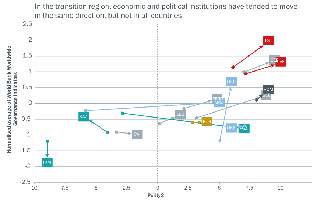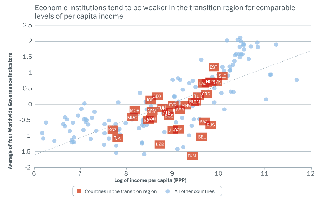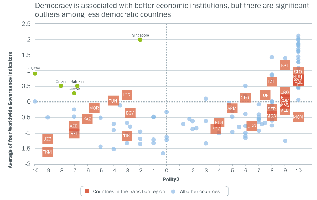Economic institutions
Building better economic institutions
How can countries improve their economic institutions? Cross-country analysis shows that institutional quality depends not only on a country’s level of democracy, but also on many other factors. Some of these are fixed or difficult to change,...
Forces shaping economic institutions - Democracy
Chapters 1 and 2 showed that democratic political institutions – as measured by the Polity2 indicator, which ranges from -10 to +10 – are correlated with the transition indicators. Similar correlations apply when the WGIs or the distance to the...
Forces shaping economic institutions - Geography and history
To what extent might the quality of institutions be predetermined by geography or history? Tables 3.1 and 3.2 include a number of geographical variables that have been discussed in the literature on economic growth. Countries that are further...
Fractionalisation of society
Another country characteristic that can affect the success of reforms is the extent to which a society divides along ethnic lines or in other ways.1 In divided societies different groups may struggle to agree on the direction of reforms, or they...
Natural resource endowments
As shown in Chapter 2, an abundance of natural resources – reflected in high natural resource rents (revenues net of extraction costs) as a share of GDP, or a large share of commodities in total exports – can lead to a weakening of democratic...
Economic openness and the EU “anchor”
Openness in terms of trade flows (measured by the trade intensity index, which compares a country’s share of world trade with its share of world output)1 and finance (measured by the Chinn-Ito index of capital account openness) is significantly...
Political systems in multi-party democracies
Chart 3.5 shows that the quality of economic institutions varies widely among countries with Polity2 scores of between 8 and 10. In addition to the reasons considered so far, another possible explanation might be differences in the design of...
Local and regional variation in institutional quality
There can be large differences in the quality of local and regional institutions. An analysis using data from the most recent (2010) LiTS found that only about 20 per cent of the variation in the performance of local governments as perceived by...
Critical junctures: a comparison
The above analysis confirms the strong (and probably causal) effect of democracy on economic institutions and the likely relevance of several other factors: history, geography, per capita income levels, the presence of natural resources,...
Early transition histories and vested interests
In Romania and Ukraine resistance to reform developed among strong vested interests following the collapse of central planning, although for rather different reasons.1
In Romania the former communist elites initially retained power, controlling...
Political polarisation
Political polarisation is defined in the transition context as the strength, in terms of the number of parliamentary seats, of the largest post-communist faction when an anti-communist faction is in power and vice versa (see previous section)....
Priorities of government leaders and their advisers
Although observers of the Rose Revolution and its aftermath in Georgia disagree on Mikheil Saakashvili’s overall presidential record, there can be little doubt that the success with institutional reforms reflected his priorities. In turn, these...
External anchors and external support
According to several authors, the prospect of EU accession created incentives for reform in many transition countries – particularly after they had submitted membership applications, and most directly during the membership negotiation phase, when...
Macroeconomic environment
The above episodes took place under very different macroeconomic conditions, which may have had an impact on demand for reform and its implementation. In the Slovak Republic Dzurinda’s tenure began in a low-growth environment, from which the...
Conclusion
Reform-oriented policy-makers can attempt to improve economic institutions by “just doing it”: by passing an anti-corruption law, by changing the management and accountability relationships of a customs agency, by abolishing licensing...
Box 3.1. The legacy of former empires
For better or worse, empires and colonial powers may leave a long-lasting legacy in terms of economic and political institutions.
Ottoman rule, in particular, has had persistent negative effects on financial development and social norms relating...
Box 3.2. Ethnic divisions in the Kyrgyz Republic
The Kyrgyz Republic was the first Central Asian country to adopt market-oriented reforms, proceeding faster and further than neighbouring countries with privatisation and the liberalisation of prices and foreign exchange. It joined the WTO in...
Annex 3.1. A new dataset on the corporate governance of banks
Table A.3.1.1 shows the main findings of an assessment of the corporate governance of banks in 16 countries in eastern Europe and Central Asia conducted by the EBRD’s Legal Transition Team. The assessment focused mainly on internal corporate...
Annex 3.2. Sources and definitions of variables for cross-country regressions
Variable
Source
Description
WGI average
World Bank, 2012
Average of four Worldwide Governance Indicators: rule of law, government effectiveness, control of corruption and regulatory quality. Each index is on a scale of -2.5 (lowest...
References
A. Alesina, R. Baqir and W. Easterly (1999)“Public goods and ethnic divisions”, Quarterly Journal of Economics, 114 (4), pp. 1243-1284.
A. Aslund (2013)How capitalism was built, Cambridge University Press.
A. Aslund, P. Boone and S. Johnson...



















